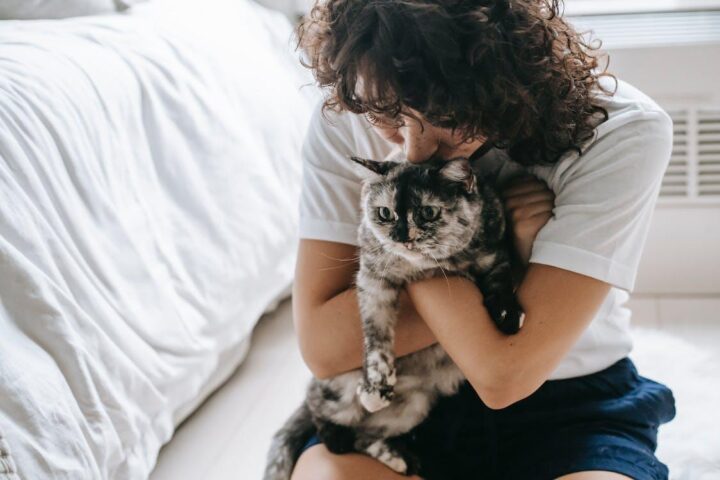Tips and Tricks for Owning a Pet in College
Life on a college campus is filled with excitement, trials, and a newfound sense of freedom. It represents an era where self-exploration, personal development, and the creation of enduring memories take center stage.
Amid academic pursuits and social escapades, some students discover comfort and companionship in the presence of a furry, feathered, or scaled pet. Embracing pet ownership during college can be a source of gratification; however, it does necessitate a level of commitment and poses some hurdles.
But worry not; we’ve curated valuable insights and advice designed to assist college students in effectively managing the responsibilities of pet ownership while skillfully harmonizing them with their academic and social commitments. Let’s plunge in.

Research and Choose the Right Pet
When it comes to owning a pet in college, the journey begins with one crucial decision: selecting the right pet. It’s a choice that will impact your life and your future furry, feathery, or scaly companion. First, you need to consider your lifestyle and what kind of pet will seamlessly blend into it.
Think about the time you can realistically allocate to a pet. Are you a busy bee with a packed schedule, or do you have more flexible hours? Some pets demand more time and attention than others.
The place you call home during college is another pivotal factor in your pet choice. Unfortunately, not all dorms or rental properties are pet-friendly, and many have strict regulations. If you live in a dorm, check your college’s pet policies.
Some campuses have designated pet-friendly dorms, while others completely ban pets. Regarding off-campus housing, speak with your landlord or roommates about their pet policies. Choosing a pet that aligns with your living circumstances and abides by the rules is vital.
Different pets come with different price tags. Dogs, for example, can be costlier to care for due to their higher food and medical costs, while small rodents or reptiles require less expenditure. Estimating these costs and ensuring they align with your budget is important. You might need to cut back on non-essential spending to accommodate your pet’s financial needs.
Budget Wisely
College life is when budgeting skills become a survival tool. You have to budget for several things, such as transport, groceries, entertainment, clothing, study materials, and even buying papers from sites like essayusa service.
The same applies to pet ownership. The financial aspect of caring for a pet is a critical component that you need to handle wisely to ensure your pet leads a happy and healthy life. Let’s dive into the financial side of pet ownership and discover how to budget wisely without breaking the bank.
Calculate the Costs
Before bringing a pet into your life, it’s essential to have a clear understanding of the potential expenses. Pets come with various costs, including:
- Food: different pets have different dietary requirements, and some may have pricier tastes than others. Be sure to research the dietary needs of your chosen pet and calculate the monthly food costs.
- Veterinary care: pets require vaccinations, regular check-ups, and preventive care. Depending on the pet’s age, species, and unforeseen health issues, these expenses can vary.
- Grooming and supplies: some pets, like long-haired breeds or certain reptiles, may require regular grooming or specialized equipment. Additionally, you’ll need to budget for items like bedding, toys, and litter.
- Emergency funds: pets, like humans, can experience accidents or health issues. putting money aside for emergencies for such situations is a wise financial move.
Create a Pet Budget
Once you’ve estimated the related costs, create a pet budget. This budget should be integrated into your overall financial planning. List all the expected costs, and don’t forget to allocate a portion of your budget for potential emergencies.
Regularly Review and Adjust Your Budget
As your college life evolves, your financial situation may change. It’s crucial to revisit your pet budget periodically and make necessary adjustments.
Create a Pet-Friendly Living Space
Where you live plays a pivotal role in your pet’s well-being. Making it safe and comfortable will help to ensure a peaceful coexistence. Before your pet moves in, take a moment to assess your living space with a keen eye for potential hazards. Pets are naturally curious, and their penchant for exploring can lead them into trouble. Here are some steps to pet-proof your space:
- Hide electrical cords: pets may be tempted to chew on cords, which can be dangerous. Use cord protectors, hide cords out of reach, or invest in cordless devices when possible.
- Remove toxic plants: some common houseplants can be toxic to pets. Check and remove any poisonous flora from your living area.
- Secure trash bins: pets are notorious scavengers, and a tipped-over trash bin can lead to a messy and potentially hazardous situation. Invest in pet-proof trash containers or secure the bin in a cabinet.
- Lock away cleaning supplies: household cleaning supplies can be harmful if ingested. Store them in a secure cabinet or out of your pet’s reach.
To create an organized living space, designate a specific area for your pet’s needs. It includes an area for food and water dishes, a spot for their bed or crate, and a designated potty area if you have a dog. Having designated spaces keeps your living area organized and helps your pet establish a sense of routine.
If you’re sharing your living space with roommates or housemates, communicate about your pet’s designated areas and any shared responsibilities. Having a clear plan in place can prevent misunderstandings and potential conflicts.
Maintaining a pet-friendly living space involves regular cleaning and maintenance. Clean up pet hair, spills, and accidents promptly to prevent odors and damage. Regularly wash pet bedding and toys to keep your living space fresh and hygienic.
Stick to a Routine
In the whirlwind of college life, where schedules can be unpredictable, and assignments seem to multiply overnight, sticking to a routine is like having a compass to navigate the chaos. When it comes to your pet, a well-structured daily routine ensures their physical and emotional well-being and helps you maintain a sense of balance in your busy life.
Routines are important for pets, especially when it comes to meals. Dogs and cats, in particular, come to expect their breakfast and dinner at the same time each day. Their feeding schedule is equally crucial if you’re raising a small critter or a reptile.
Set specific feeding times for the animal and stick to them as closely as possible. This consistency helps the pet anticipate meal times and can prevent them from becoming anxious or overly demanding. It’s also beneficial for house-training your pet.
Exercise is a vital component of your pet’s health and happiness. Dogs need daily walks and playtime, while cats enjoy interactive play with toys. For smaller pets like hamsters or birds, provide an environment that encourages physical activity. Exercising helps reduce behavior issues and keeps the pet in good shape, both physically and emotionally.
If you have a dog, potty breaks are essential. Set a schedule for regular walks or outdoor bathroom breaks. Consistency helps with house training and prevents accidents indoors. Cats and small critters usually have litter boxes. Keep these clean by scooping waste daily. Replace the litter as needed, and regularly wash the litter box to maintain hygiene and a pleasant environment for the pet.
Pets aren’t just a part of your routine but a part of your life. Spend quality time with the animal to nurture your bond. Whether cuddling on the couch, playing games, or simply sitting together, these moments are vital for building trust and companionship. Quality time isn’t just about physical presence but also about showering the animal with love and affection. Give positive reinforcement for good behavior to create a nurturing and positive atmosphere.
Invest in Training and Socialization
Owning a pet in college isn’t just about providing food, shelter, and love; it’s also about helping the animal become a well-behaved and socially adjusted community member. It’s where pet training and socialization come into play.
Enrolling your furry friend in obedience classes is often a wise choice if you’re a dog owner. Many communities offer affordable dog training classes. Check with local trainers or your college’s resources to find options for your budget and schedule.
Training may involve different methods for pets like cats, small critters, or birds. For example, you can train your cat to use a litter box or a specific scratching post. Small critters may be trained to perform simple tricks or respond to their names. Consistency and positive reinforcement are key, regardless of your pet’s species. Both training and socialization require consistency and patience.
Final Thoughts
Embracing the role of a pet owner during your college years can be a rewarding experience, but it’s also accompanied by its fair share of responsibilities and challenges. It’s vital to remember that pet ownership entails a long-term commitment that necessitates well-informed decisions based on carefully considering your unique lifestyle, financial resources, and individual preferences. By approaching this journey with the right mindset and a willingness to invest that extra effort, you can foster a harmonious and affectionate environment for yourself and the pet.


